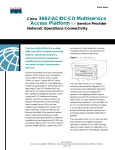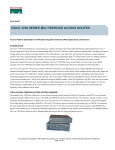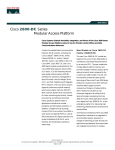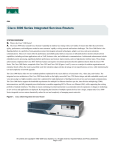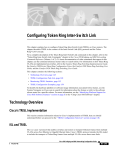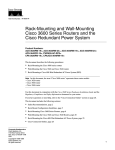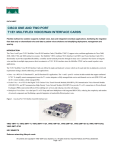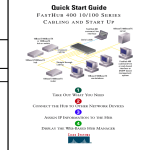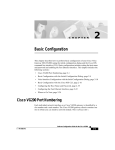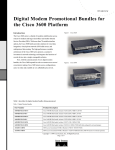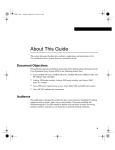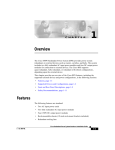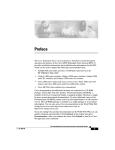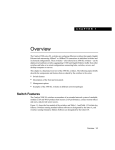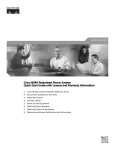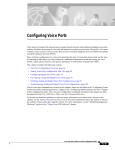Download Cisco MODEM MANAGEMENT TECHNOLOG
Transcript
O VERVIEW Cisco 3600 Series ATM OC-3 Network Modules Introduction 3600, providing robust QoS features for applications at the In late 1996 Cisco Systems introduced the Cisco 3600 series branch-office LAN such as videoconferencing, distance family of modular, cost-effective, and high-performance dial learning, video broadcast, and voice/fax over IP over ATM access routers targeted at regional and branch office and applications. small to medium-sized Internet Service Providers (ISPs). Over The OC-3 ATM network modules developed for the the next two years, the Cisco 3600 series announced further Cisco 3600 modular access routers provides a single-port extensions to the platform with support for Fast Ethernet, SONET and SDH-based OC-3c/STM-1 interface for voice/fax over IP, internal digital and analog modems, worldwide use. These modules are designed to support the high-density asynchronous dial, ATM25/ADSL, and convergence of data, voice, and video services that allow High-Speed Serial Interface (HSSI), adding multifunction customers to migrate existing voice and video traffic onto a capabilities to the initial dial-access solutions. corporate data network for substantial cost savings. Now, with the announcement of three new versions of ATM OC-3 network modules, the Cisco 3600 series further Figure 1 Cisco 3600 Series ATM OC-3 Network Modules expands its flexibility as a multifunctional branch office solution for service provider and enterprise customers. These new modules add to the broad portfolio of Cisco ATM Customer Provided Equipment (CPE) and central office products, that allow branch offices to take advantage of the higher bandwidth and quality of service (QoS) available with ATM services. High-speed ATM access on the Cisco 3600 provides cost-effective, value-added, high-speed managed router services to both enterprise and service provider customers. The new ATM OC-3 network modules address the growing demand for improved ATM QoS features, combined with the advanced Layer 3 class of service (CoS) capabilities provided by a router. Users now have the ability with the Table 1 These ATM Network Modules are Being Introduced Cisco 3600 series to provide robust QoS mechanisms for prioritization of traffic from legacy and high-speed LANs Product Number Description over an ATM network. These new network modules allow NM-1A-OC3MM Single-Port 155-Mbps ATM OC-3 Multimode Network Module NM-1A-OC3SMI Single-Port 155-Mbps ATM OC-3 Single-Mode Intermediate Reach Network Module NM-1A-OC3SML Single-Port ATM 155-Mbps OC-3 Single-Mode Long-Reach Network Module the Cisco 3600 series to enter the high-speed ATM access market by providing solutions that enable ATM broadband services to fit into many companies communications budgets, not just the very large corporations. Managers can now cost-effectively terminate high-speed ATM on the Cisco Copyright © 1999 Cisco Systems, Inc. All Rights Reserved. Page 1 of 11 Features at a Glance other advanced ATM Layer 2 features such as Internet • RFC 1483 support for multiple encapsulations over ATM Engineering Task Force (IETF) Point-to-Point Protocol (PPP) • RFC 1577 support for routing over ATM over ATM, Tag Switching, multiprotocol over ATM • ATM service classes: UBR, UBR+, VBR-rt, VBR-nrt, ABR, (MPOA), and multilayer switching (MLS) enhancing ATM performance for enterprise and service providers. and CBR (data only) • ATM Forum UNI 3.0, UNI 3.1, and UNI 4.0 These ATM network modules also allow the Cisco 3600 • AAL5 ATM adaptation layer series modular access routers to provide advanced Cisco • Up to 1024 simultaneous Virtual Circuits (VCs) IOS® features, such as Committed Access Rate (CAR), RSVP, • Layer 2 per-VC queuing and traffic shaping Cisco Express Forwarding (CEF), and Cisco IOS Firewall • ATM PVCs and SVCs Feature Set to provide the customer with end-to-end QoS. • Permanent Virtual Paths (PVPs) (up to three) The benefits of a high-speed ATM connection from • LANE 2.0 client and server branch office to a regional or corporate headquarters include • F4 and F5 Operations and Maintenance (OAM) cell support the transfer of high-speed data and support for new • ABR SVCs multimedia applications including voice, video, and • MPOA client and server distance-learning applications. Using an ATM transport • Tag Switching (MPLS when approved) allows for application-specific QoS to be used, especially • IETF PPP over ATM important for the next generation of delay-sensitive • Next Hop Resolution Protocol (NHRP) multimedia traffic. The integration of VoIP over ATM and • ATM bandwidth (resource) manager data applications over ATM is ideal for delivering low • Interim Local Management Interface (ILMI) latency, jitter-free voice support due to ATM’s support for • ATM UNI 4.0 traffic management high transmission speeds, prioritization techniques, and • Frame User to Network Interface (FUNI) built-in QoS features. The combination of Layer 2 and Layer 3 QoS features ATM OC-3 Network Module Features and Benefits with the Cisco 3600 series ATM OC-3 network modules The ATM OC-3 network modules provides robust ATM QoS allows service providers to effectively manage the bandwidth capabilities of Layer 2 per-VC queuing, bandwidth at the edges of the network while implementing value-added management, and robust ATM service categories such as Layer 3 services. With advanced traffic-shaping features and UBR+, VBR-rt, VBR-nrt, and ABR. With these new ATM support for many ATM service classes (including VBR-rt, service categories, users have more flexible access to network VBR-nrt, and ABR), the ATM OC-3 network modules can be resources and can achieve a compromise between effectively deployed as ATM edge router devices in the performance and cost. Additionally, network operators are service provider network. able to share network resources among different customers The Cisco 3600 series with OC-3 ATM network and fulfill their needs in a cost-effective manner. Users can modules can be used by service providers in a Tag Switching now better optimize the application requirements as environment. Tag Switching enables routers at the edge of a compared to the network capabilities and can select a specific network to apply simple tags to packets, while devices in the combination of traffic and performance parameters. core of the network switch packets according to these tags. The ATM OC-3 network modules are ideal for Switches, such as ATM switches, or existing routers, can connecting directly to ATM Wide Area Network (WAN) at perform Tag Switching in the core. These systems will run large, remote, branch office sites to a central site via a public Tag Switching software, which communicates with tag or privately owned ATM WAN or for connections to a routers on the edge using a Tag Distribution Protocol. For colocated Cisco ATM switch to provide integrated Circuit multiservice networks, Tag Switching enables a Cisco 3600 Emulation Service (CES) data, voice, and video support. to provide ATM, Frame Relay, and IP Internet service all on Voice over IP (VoIP) over ATM applications is supported a single platform in a highly scalable way. Supporting all of using the currently available voice/fax network modules and these services on a common platform provides operational associated voice interface cards. Support is also provided for cost savings and deployment ease to multiservice providers. Copyright © 1999 Cisco Systems, Inc. All Rights Reserved. Page 2 of 11 Cisco IOS VPN features combined with traffic-shaping Customer Applications features are key in ensuring that traffic from one customer The following diagrams describe four applications for does not impact traffic from another. Lower operating costs deployment of high-speed OC-3 ATM network modules for are provided with the Cisco 3600’s central management the Cisco 3600 series for integrated data, voice, and video for capabilities. The Cisco 3600 and its interfaces can be large branch office, campus edge router, VoIP over ATM, and managed with CiscoWorks and CiscoWorks2000 Network co-located router with ATM switch solutions. The OC-3 ATM network modules can be deployed in Management. In addition, by providing support for ATM specific MIBs including RFC 1406, 1595, 1695, and 2233, public or private ATM WANs to support transparent LAN network managers have control over network statistics services (TLS) where data rate requirements range between and the ability to configure and tune the network for a 10 and 80 Mbps. central location. Comprehensive debugging tools available in Cisco IOS can substantially reduce time and costs associated with ATM network problem isolation and correction. Figure 2 Directly Connected ATM WAN for Large Branch- and Remote-Office Applications Corporate Headquarters Token Ring Token Ring LAN-Based Video Cisco 3620 ® LightStream 1010 DS3/OC-3 OC-3 Cisco 3620 ATM WAN OC-3 Branch Office Locations T1/E1 Cisco MC3810 Campus WAN Cisco 7200/7500 DS3/OC-3 Token Ring Token Ring Cisco 4500/4700 DS3/OC-3 Copyright © 1999 Cisco Systems, Inc. All Rights Reserved. Page 3 of 11 Figure 3 VoIP, Video, and Data Integration Over High-Speed ATM VBR-rt SVC Support for VoIP and H.323 Remote Office or School Cisco 3640 PBX LightStream 1010 ™ ™ OC-3 IGX /MGX 10/100BaseT LAN DS3 LAN-Based Video OC-3 ATM Public/Private WAN 10/100BaseT LAN DS3 Remote Office or School Cisco 3620 ® DS3 PBX DS3 Cisco 3620 OC-3 Cisco 3640 LS1010 IGX/MGX OC-3 10/100BaseT LAN 10/100BaseT LAN LAN-Based Video Currently up to 12 voice ports are supported on the Cisco 3640 with an OC-3 ATM configured network module. Voice/Fax over IP over ATM can be supported using VBR-rt CoS SVCs for VoIP and H.323 applications across the ATM WAN. Figure 4 CES Data, Voice, and Video Integration with Colocated Cisco ATM Switches Video Cisco 3620 PBX OC-3 ATM CES/Voice LightStream 1010 Switch PBX PBX Cisco 3640 ATM Switch CES/Voice OC-3 ATM ATM WAN CES/Voice Cisco 3640 OC-3 ATM ATM Switch IGX/MGX Switch Video OC-3 ATM Video PBX When colocated with an ATM WAN switch, the Cisco 3600 with OC-3 ATM interfaces provides legacy and high-speed LAN connectivity, along with ISDN and hybrid dial-access concentration, Frame Relay, PPP, X25, or HDLC access, VoIP, synchronous and asynchronous WAN aggregation, ATM25, or HSSI. Copyright © 1999 Cisco Systems, Inc. All Rights Reserved. Page 4 of 11 Figure 5 Campus ATM Edge Router Integration of Voice, Dial, and WAN Applications Cisco 2600 Cisco MC3810 Ethernet/ATM Switched Campus LAN with ATM uplink to Cisco 3600 Cisco 3620 Frame Relay PBX Cisco 3640 PBX PSTN/Voice and Dial OC-3 ATM Catalyst ® 5x00/ Catalyst 85x0 Cisco 4700 PBX ISDN Positioned on the edge of an ATM or Ethernet-switched ATM service class, the ATM OC-3 network modules support network, the Cisco 3600 with high-speed ATM provides the highly configurable parameters: peak cell rate (PCR), ability to support a wide range of voice and data connectivity sustainable cell rate (SCR), maximum burst size (MBS), and options such as ISDN and hybrid dial-access concentration, minimum cell rate (MCR). These parameters can be defined Frame Relay, PPP, X25, or HDLC access, VoIP, voice over based on the specific bandwidth requirements of an Frame Relay (VoFR), synchronous and asynchronous WAN individual VC as needed for a specific application. aggregation, ATM25, or HSSI. Supporting traffic shaping in the hardware means that there is no performance degradation when shaping is enabled. ATM Traffic-Shaping Feature The Layer 2 per-VC queuing support for ATM traffic Traffic shaping is a function typically provided on ATM edge shaping has a simple mechanism in place that ensures that devices to ensure that bursty traffic conforms to predefined one, or a few, VCs do not consume all the transmit resources parameters. Traffic shaping ensures that traffic from one VC on the router. This is done by limiting the number of transmit does not adversely impact another resulting in data loss. This buffers available on a per-connection basis. This prohibits a function is very important when connecting to an ATM single VC or VP from oversubscribing all the transmit WAN or public ATM network; especially when the ATM resources of the interface. The OC-3 network modules have switches enable traffic policing that will discard all traffic only one transmit queue for all VCs. The minimum that exceeds the predetermined contract at the ingress of the configurable bandwidth is 64 Kbps. Even though a switch. contiguous range of bandwidth can be configured, the The OC-3 network modules support Layer 2 per-VC granularity is limited to 37 Kbps. queuing and implement traffic shaping functionality using UBR, UBR+, VBR-rt, VBR-nrt, ABR, or CBR ATM traffic classes. Each of these service classes has a unique way to shape traffic to specific customer requirements. For each Copyright © 1999 Cisco Systems, Inc. All Rights Reserved. Page 5 of 11 Advanced Bandwidth Management Feature ATM Layer Management Advanced bandwidth management mechanisms in the ATM Operations and management (OAM) cells are used for ATM OC-3 network modules architecture allow for the support of layer end-to-end link management messages. This is bursty, client/server traffic while supporting applications that necessary to ensure that the remote connection is alive and require guaranteed or best-effort service. The ATM OC-3 functioning. Support is provided for both OAM F4 and F5 network modules’ bandwidth management capabilities flows. During segmentation the OAM cells have the highest exceed those of existing ATM interface in midrange routers. priority, and will be transmitted ahead of other queued up This new feature provides the ability to keep track of the bandwidth used by a VC on a per-interface basis. It prevents data. During reassembly, the OAM traffic will be routed to a global OAM receive buffer pool of 512 64-byte buffers. the oversubscription of the ATM link and is configurable by the user. Bandwidth Manager for CBR is turned on automatically for all interfaces supporting CBR. All other ATM service categories need to be manually configured. The total bandwidth allocated on the interface is tracked by aggregating the values specified below for each VC. Whenever a new VC is requested, the requested rate is checked against the available rate to ensure the available bandwidth is not exceeded. Orderability, Availability, Software, and Memory Requirements Table 2 ATM- OC-3 Network Modules for Cisco 3600 Series Routers Part Number Descriptions NM-1A-OC3MM (=) Single-Port ATM OC-3c/STM1 Multimode Network Module March 1999 12.0(3)T Plus feature sets NM-1A-OC3SMI (=) Single-Port ATM OC-3c/STM1 Single-Mode, Intermediate Reach Network Module March 1999 12.0(3)T Plus feature sets NM-1A-OC3SMl (=) Single-Port ATM OC-3c/STM1 Single-Mode, Long-Reach Network Module March 1999 12.0(3)T Plus feature sets Orderable/Available Date IOS Requirement Note: no additional DRAM memory is required to support the OC-3 ATM network modules, other than Cisco IOS Release 12.0(3)T Plus specified minimum memory requirements. More detailed information of 12.0(3)T feature set memory requirements are available in the Cisco 3600 series 12.0(3)T Product Specific Release Notes. Copyright © 1999 Cisco Systems, Inc. All Rights Reserved. Page 6 of 11 Technical Specifications ATM Services • ATM Forum UNI 3.0, 3.1 and 4.0 signaling for ATM OC-3 Network Module System Requirements • Only supported on the Cisco 3600 series routers at this time point-to-point and point-to-multipoint virtual circuits • ATM Forum UNI 4.0 signaling for ABR SVCs • ATM Forum ILMI for address prefix acquisition and ATM • Not supported on the Cisco 2600 series • No slot placement restrictions on either platform • Maximum recommended on a single Cisco 3640 and Cisco 3620 is one service address registration with UNI-compliant switches throughout the ATM network • ATM network service access point (NSAP) E.164 address support • Max two high-speed network modules in a Cisco 3640 (includes Fast Ethernet, ATM, HSSI) • F4 (virtual path) and F5 (virtual connection) OAM cell segment and end-to-end flows, remote deflect identification • Requires Plus feature sets of Cisco IOS Release 12.0(3)T (RDI), and alarm indication signal (AIS) or above • Operates in conjunction with all currently available Cisco 3600 network modules and WAN interface cards (WICs) Network Management • The ATM OC-3 network modules will support the following Management Information Buses (MIBs): Physical Characteristics – MIB II • One OC-3c/STM-1 SC type connector per network module • Support SDH G.707 and G.708 specifications • 4 LEDs including: – Synchronous Optical Network (SONET) MIB – ATM MIB – ATM ILMI MIB – Enabled—Network module is seated correctly and is communicating to the bus – LANE MIB – RFC 406, 1595, 1695, and 2233 – RCLK—Carrier detect • CiscoWorks2000 and CiscoWorks network management – FERF—Far end Rx failure integration – OOF—Out of frame error condition • Enhanced setup configuration – AIS—Alarm indication • Text-based command-line interface (CLI) • Maximum distance support of 2 km for Multimode, 15 km for single-mode, Intermediate reach, and 45 km for Positioning single-mode, long-reach versions. A maximum of one ATM OC-3 network module is recommended on both the Cisco 3640 and 3620. The Cisco ATM Standards Supported • Multiprotocol encapsulation with support for Logical Link 3620 and 3640 will not support full 155-Mbps OC-3 line Control/Subnetwork Access Protocol (LLC/SNAP) rates. The actual maximum supported speed ranges between encapsulation and VC multiplexing (Internet Engineering 20 and 80 Mbps, depending on packet size. Layer 2 traffic Task Force [IETF] RFC 1483) shaping, bandwidth management, and improved ATM CoS • Classical IP and Address Resolution Protocol (ARP) over features including UBR, UBR+, VBR-rt, VBR-nrt, CBR, and ATM; client and ARP server (IETF RFC 1577; IETF RFC ABR of the OC-3 ATM network modules on the Cisco 3600 1755; IETF RFC 1626) series make it an ideal choice for service providers who want • MPOA for IP, Novell IPX, DECnet, AppleTalk Phases 1 to provide differentiated, end-to-end solutions that combine and 2, Connectionless Network Service (CLNS), Xerox the performance and traffic management benefits of Layer 2 Network Systems (XNS), and Banyan VINES via IETF switching with the intelligence, scalability, and functionality RFC 1483 of Layer 3 routing. The Cisco 3600 series ATM OC-3 • ATM Forum LAN Emulation (LANE) including LEC, BUS, LES, and LECS network modules should be considered in situations where a multiservice platform with VoIP, hybrid dial access with • IETF PPP over ATM integrated modems, or integrated DSU/CSU functionality is • MPOA required. • Tag Switching/MPLS (when approved) Copyright © 1999 Cisco Systems, Inc. All Rights Reserved. Page 7 of 11 Summary Network Module Description NM-1A-OC3SMI One-port 155-Mbps single-mode intermediate-reach network module NM-1A-OC3SML One-port 155-Mbps single-mode long-reach network module modularity, scalability, investment protection, and flexibility. NM-1ATM-25 One-port ATM 25-Mbps network module With the addition of these three new ATM network modules NM-1HSSI One-port high-density serial interface network module can extend their investments in Cisco 3600 products and take NM-16A 16-port high-density async network module advantage of the higher bandwidth and QoS features NM-32A 32-port high-density async network module NM-4T Four-port serial network module NM-4A/S Four-port async/sync serial network module NM-8A/S Eight-port async/sync serial network module The Cisco 3600 is a multifunction platform with the ability to support hybrid dial access, LAN-to-LAN routing, WAN aggregation, multiservice functions, and ATM connectivity in the same chassis. Additional benefits include increased to the Cisco 3600 series modular access routers, companies available with ATM services. Appendix A Cisco 3600 Family Overview, Network Module, and WIC Summary The following tables detail the range of platforms and Table 5 LAN Network Modules and Mixed-Media LAN/WAN Network Modules current network modules available in the Cisco 3600 series. Network Module Description Table 3 The Cisco 3600 Platforms NM-1FE-FX One-port Fast Ethernet network module (10/ 100BaseFX only) NM-1FE-TX One-port Fast Ethernet network module (10/ 100BaseTX only) NM-4E Four-port Ethernet network module NM-1E One-port Ethernet network module NM-1E2W One-port Ethernet, 2 WAN card slot network module NM-2E2W Two-port Ethernet, 2 WAN card slot network module NM-1E1R2W One-port Ethernet, one-port Token Ring, 2 WAN card slot network module Feature Cisco 3640 Cisco 3620 Processor Type 100-MHz IDT R4700 RISC 80-MHz IDT R4700 RISC Flash Memory 4 MB, upgradable to 32 MB 4 MB, upgradable to 32 MB System Memory 32-MB DRAM, upgradable to 128-MB DRAM 32-MB DRAM, upgradable to 64-MB DRAM Network Module Slots 4 slots 2 slots Power AC, DC, Redundant Power Option AC, DC, Redundant Power Option Dimensions 3.44 x 17.5 x 15.75 in. (H x W x D) 1.69 x 17.5 x 14.25 in. (H x W x D) Performance 50 to 70 Kpps 20 to 40 Kpps Console and Auxiliary Ports (up to 115.2 kbps) Yes Yes Rack and Wall Mounting Yes Yes Dual Type II PCMCIA Card Slots Yes Table 6 ISDN and Channelized Serial Network Modules Network Module Description NM-1CT1 One-port channelized T1/ISDN PRI network module NM-1CT1-CSU One-port channelized T1/ISDN PRI with CSU network module NM-2CT1 Two-port channelized T1/ISDN PRI network module NM-2CT1-CSU Two-port channelized T1/ISDN PRI with CSU network module NM-1CE1B One-port channelized E1/ISDN PRI balanced network module NM-1CE1U One-port channelized E1/ISDN PRI unbalanced network module Yes The Cisco 3600 Network Modules Table 4 Cisco 3600 Series Network Modules Network Module Description NM-1A-OC3MM One-port 155-Mbps multimode OC-3 ATM network module Copyright © 1999 Cisco Systems, Inc. All Rights Reserved. Page 8 of 11 Table 6 ISDN and Channelized Serial Network Modules (Continued) Part Number Description Network Module Description VIC-2FXO Two-port FXO voice/fax interface card NM-2CE1B Two-port channelized E1/ISDN PRI balanced network module VIC-2E/M Two-port E&M voice/fax interface card VIC-2FXO-M3 Two-port voice interface card—FXO for Australia NM-2CE1U Two-port channelized E1/ISDN PRI unbalanced network module VIC-2FXO-EU Two-port voice interface card— FXO for Europe VIC-2BRI-S/T-TE Two-port voice interface card—BRI (terminal) NM-1FE1CT1 One-port 10/100BaseTX Ethernet with one-port PRI/ channelized T1 NM-1FE1CT1-CSU One-port 10/100BaseTX Ethernet with one-port PRI/ channelized T1 with integrated CSU NM-1FE2CT1 One-port 10/100BaseTX Ethernet with two-port PRI/ channelized T1 NM-1FE2CT1-CSU One-port 10/100BaseTX Ethernet with two-port PRI/ channelized T1 with integrated CSUs NM-1FE1CE1B One-Port 10/100BaseTX Ethernet with one-port PRI/ channelized E1 balanced mode (120 ohm) NM-1FE2CE1B One-port 10/100BaseTX Ethernet with two-port PRI/ channelized E1 balanced mode (120 ohm) NM-1FE1CE1U One-port 10/100BaseTX Ethernet with one-port PRI/ channelized E1 unbalanced mode (75 ohm) NM-1FE2CE1U One-port 10/100BaseTX Ethernet with two-port PRI/ channelized unbalanced mode (75 ohm) NM-4B-S/T Four-port ISDN BRI network module NM-4B-U Four-port ISDN BRI with NT-1 network module NM-8B-S/T Eight-port ISDN BRI network module (S/T interface) NM-8AM Eight-port analog modem network module NM-16AM 16-port analog modem network module MMTL-3600/2600-8 Modem Management Technology License for 8 modems MMTL-3600/2600-16 Modem Management Technology License for 16 modems NM-8B-U Eight-port ISDN BRI with NT-1 network module (U interface) NM-6DM Six digital modem network modules NM-12DM 12 digital modem network modules NM-18DM 18 digital modem network modules NM-24DM 24 digital modem network modules NM-30DM 30 digital modem network modules MICA-6MOD(=) Six digital modem upgrade cards Table 7 Voice Network Modules and Voice Interface Cards (VICs) Part Number Description NM-1V One voice/fax interface card slot network module NM-2V Two voice/fax interface card slot network module VIC-2FXS Two-port FXS voice/fax interface card Copyright © 1999 Cisco Systems, Inc. All Rights Reserved. Page 9 of 11 Table 8 Other Part Number Description PWR600-AC-RPS-NCAB 600W redundant power supply option (requires Cisco 3600 RPS chassis) NM-COMPR Compression network module WAN Interface Cards WAN interface cards are available as daughter cards to the mixed-media LAN/WAN network modules. Up to two WAN interfaces cards can be installed on a single mixed-media LAN/WAN network module. The WAN interface cards are not included in the price of the mixed-media network modules. Part Number Description Serial WIC WIC-1T One-port sync serial WIC-1DSU-T1 One-port sync serial with build in CSU/DSU WIC-1DSU-56K4 One-port, four-wire 56-kbps CSU/DSU ISDN WIC WIC-1B-S/T One-port ISDN BRI WIC-1B-U One-port ISDN BRI with NT1 Copyright © 1999 Cisco Systems, Inc. All Rights Reserved. Page 10 of 11 Corporate Headquarters Cisco Systems, Inc. 170 West Tasman Drive San Jose, CA 95134-1706 USA http://www.cisco.com Tel: 408 526-4000 800 553-NETS (6387) Fax: 408 526-4100 European Headquarters Cisco Systems Europe s.a.r.l. Parc Evolic, Batiment L1/L2 16 Avenue du Quebec Villebon, BP 706 91961 Courtaboeuf Cedex France http://www-europe.cisco.com Tel: 33 1 69 18 61 00 Fax: 33 1 69 28 83 26 Americas Headquarters Cisco Systems, Inc. 170 West Tasman Drive San Jose, CA 95134-1706 USA http://www.cisco.com Tel: 408 526-7660 Fax: 408 527-0883 Asia Headquarters Nihon Cisco Systems K.K. Fuji Building, 9th Floor 3-2-3 Marunouchi Chiyoda-ku, Tokyo 100 Japan http://www.cisco.com Tel: 81 3 5219 6250 Fax: 81 3 5219 6001 Cisco Systems has more than 200 offices in the following countries. Addresses, phone numbers, and fax numbers are listed on the Cisco Connection Online Web site at http://www.cisco.com/offices. Argentina • Australia • Austria • Belgium • Brazil • Canada • Chile • China • Colombia • Costa Rica • Croatia • Czech Republic • Denmark • Dubai, UAE Finland • France • Germany • Greece • Hong Kong • Hungary • India • Indonesia • Ireland • Israel • Italy • Japan • Korea • Luxembourg • Malaysia Mexico • The Netherlands • New Zealand • Norway • Peru • Philippines • Poland • Portugal • Puerto Rico • Romania • Russia • Saudi Arabia • Singapore Slovakia • Slovenia • South Africa • Spain • Sweden • Switzerland • Taiwan • Thailand • Turkey • Ukraine • United Kingdom • United States • Venezuela Copyright © 1999 Cisco Systems, Inc. All rights reserved. Printed in USA. IGX, IOS, and MGX are trademarks; and Catalyst, Cisco, Cisco IOS, Cisco Systems, the Cisco Systems logo, and LightStream are registered trademarks of Cisco Systems, Inc. in the U.S. and certain other countries. All other trademarks mentioned in this document are the property of their respective owners. (9901R) 2/99 B&W











